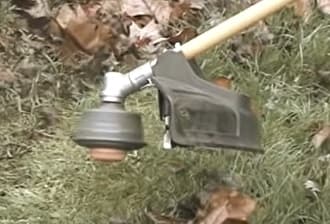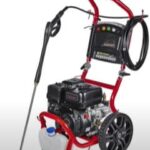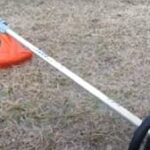As an Amazon Associate, this site earns commissions from qualifying purchases. For more information click here.
If the choke is on, air cannot reach the combustion chamber and if it is off, air can flow into the carburetor. The choke only needs to be on when you start the engine. Once the machine revs, the choke should be off. If your trimmer refuses to run without the choke, this guide can help.
If your weed eater only runs on choke, the gas cap valve is probably clogged. A dirty fuel filter or fuel line can cause the same problem. Rinsing with water should be enough to remove the dirt. If the engine continues to stall with the choke off, the filters need to be replaced.
To be clear: not all weed eaters need the choke to be on at startup. In fact, many use the choke when cold starting the engine. Either way, there is a problem if your trimmer cannot function without it.
Clogged Gas Cap
The gas cap accumulates grime through constant use. If the engine stops when you turn off the choke, the gas cap is probably covered with dirt.
To fix this, turn the engine on. Set the choke to on. Loosen the gas cap screws by 50%. Now set the choke to off and observe.
If the weed eater continues to run, clogging is probably the reason. Shut the engine down and remove the gas cap. Wash with water and soap. Rinse, dry and put it back on.
Turn the weed eater on and set choke to on. Turn the choke off after 30 seconds. If the engine stops, the gas cap is damaged and has to be replaced.
Faulty Fuel Line
Fuel reaches the carburetor through the fuel lines. If these lines are clogged or damaged, the engine won’t be able to function properly. If there is too little fuel coming in (or it gets contaminated), the engine might not run with the choke off.
Turn the engine off and examine the fuel lines. If there is damage, you need to get a replacement. To remove the fuel lines, follow these steps.
- Shut the engine off.
- Empty the fuel tank.
- With the tank open, use pliers to pull out the fuel lines and fuel filter. In some weed eaters you have to lift a cover off to access the fuel lines.
- Install new fuel lines. If necessary, clean or replace the fuel filters too.
- Reconnect the fuel lines. Put the cover plate back on. Reconnect the fuel line to the carburetor and fuel filter.
Dirty Fuel Filter
The fuel filter screens out dirt so only pure gas enters the chamber. Contaminated fuel results in poor performance and other issues. If you already replaced the fuel line and the weed eater still relies on choke, the filter is either blocked or damaged.
The fuel filter gets clogged in many ways. If you use a weed eater to mulch leaves, the cord could get damaged from heavy use.
To find out, shut off the weed whacker and open the fuel tank. You will see the fuel filter along with the fuel line.
Remove the filter. If there is damage, replace it. If it is just dirty, you might be able to wash it off. If the residue won’t come off, replace it.
The general rule is that it’s better to replace a fuel filter than clean it. Replacements are widely available and affordable. Trying to remove old fuel gunk can be messy. It is easier to just install a new filter. This is true for Troy Bilt gas string trimmers and other models.
To install a new fuel filter, turn off the weed eater. Use pliers to remove the old filter. It might be necessary to take off the fuel lines as well, so be careful.
Remember where the fuel lines are connected because you have to put them back. Install the new fuel filter and reconnect the fuel lines. Turn the trimmer on and give it a test run.
Defective Pull Cord
Gas-powered trimmers rely on a pull cord or starter rope mechanism. Usually it takes a few pulls for the engine to start. But if nothing happens, the cord might be damaged already.
The starter rope is directly connected to starting the engine. If the mechanism is broken, the air or fuel supply will be limited.
The best solution is to replace the cord or the entire pull starter assembly. Go to the official site of the manufacturer. Enter the make and model of your weed eater and you will see replacement parts and accessories available.
The starter rope mechanism varies, so follow your owner’s manual for instructions on how to install a new one.
Dirty Spark Arrestor
The spark arrestor is a fire-prevention device and found in almost all gas-powered garden tools. It also has a direct effect on the air that flows into the engine. A clogged spark arrestor prevents air from getting in and affects the fuel mixture.
To clean the spark arrestor, remove the muffler cover and detach the spark arrestor from the assembly Wipe the screen clean. When you are finished, put the screen and muffler cover back on.
If the engine stalls when you set the choke off, the spark arrestor or exhaust system might be damaged. Look for signs of wear and replace it.
Blocked Air Filter
A clogged air filter prevents air from reaching the engine. This could be one reason why there is a problem with the choke. It also prevents the exhaust system from functioning properly.
The solution depends on the condition of the air filter. It might need cleaning or have to be replaced. This is how you find out.
- Turn off the engine.
- Remove the screws on the air filter cover.
- Lift the cover. Take the filter out.
- You should be able to see how dirty the filter is. Look also for cracks or tears.
- If the filter is undamaged, wash the dirt off with soapy water. Let it dry before putting it back in place.
- If the filter is torn, replace it. As a general rule, air filters should be replaced every few months. A lot depends on how often you use the trimmer.

Clogged or Damaged Carburetor
The carburetor might be clogged with dirt or already broken. Either way you have to take the carburetor out of the weed eater to check. Before you do so, get a carburetor rebuild kit.
Whether the carburetor needs cleaning or replacement, you have to take it apart. A kit includes replacement parts in case you need it. You also get a guide on how to put the carburetor together again.
A rebuild kit is ideal if the carburetor just requires cleanup with Gumout or other cleaners. If the carburetor is already damaged, a replacement is required.
There are carburetor rebuild and replacement kits available for all the major brands. Make sure what you buy is compatible with your weed eater. Follow the instructions, install the carburetor and try to run the trimmer with the choke off.
Fuel System Blockage
If none of the above works, there is a blockage in the fuel system or engine that prevents air from coming in. It can also be due to defective components.
Check the spark plug and ignition coil. These two work together and if there is a problem with one, the other is affected. Fortunately, there are spark plug and ignition coil testers available, and you can replace them easily.
There could also be problems with the engine. The primer bulb, clutch, crankcase, trimmer head, spool etc. While not directly connected to the choke, any malfunction or defect affects the engine. You might also want to check for clogs elsewhere in the trimmer.
A common source of clogging is old fuel. Gas turns into a sticky substance and covers the engine. When this happens, fuel and air cannot be processed. The solution is to empty the fuel tank and clean it thoroughly. Pour in new fuel and that should work.

I love the outdoors and all the tools for maintaining gardens, yards and lawns. The only thing I am more passionate about is sharing what I know about garden and outdoor equipment.


